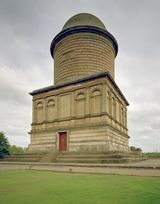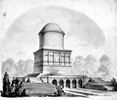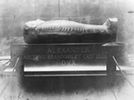 |
||||||||
| Hamilton Palace Mausoleum, Hamilton, South Lanarkshire, from south-west | ||||||||
 © RCAHMS |
Now solitary testament to the colossal scale and grandeur of the buildings which once stood in Hamilton Low Parks and a monument to the self-belief of Alexander, 10th Duke of Hamilton (1767-1852), Hamilton Palace Mausoleum is a remarkable, Roman-style domed structure of panelled masonry. Standing to an overall height of about 36.5m, it occupies a site some 200m north of the site of Hamilton Palace. Begun after 1848, the building was evidently not fully completed until about 1857, five years after the death of the 10th Duke. The distinguished Edinburgh architect, David Bryce (1803-76), was the principal designer and the associated sculptures were by Alexander Handyside Ritchie (1804-70). This view of the west face of the mausoleum shows the four stages of rusticated and panelled ashlar masonry, handsomely and intricately wrought from huge blocks of orange-coloured sandstone. From a broad, stepped terrace the mausoleum chapel is entered through a pair of wooden doors. The original doors, now stored inside, are of cast bronze, made by James Milne of Edinburgh and evidently modelled on the design of the Ghiberti doors at the Baptistry of Florence. An inscribed panel in the face of the rusticated cylinder above the entrance records (in Latin) that Alexander, 10th Duke of Hamilton, had this monument erected for himself and his family. |
|||||||
| Early in 1852, the bodies of some 16 members of the Hamilton family were brought to the mausoleum from the aisle of the medieval collegiate church which stood close to the eastern face of the palace but was then removed. Later in the same year, the 10th Duke himself died and was, in accordance with his long-planned intentions, embalmed, placed in an Egyptian sarcophagus and temporarily laid in the mausoleum chapel. In 1921, when subsidence threatened the stability of the mausoleum, most of the bodies, with the exception of the 11th and 12th Dukes (who were re-buried on Arran), were transferred to a burial plot in Bent Cemetery. | ||||||||
|
|
|
|
|
|
|
|
|
|
|
|
|
|
|
|
|
|
|
|


